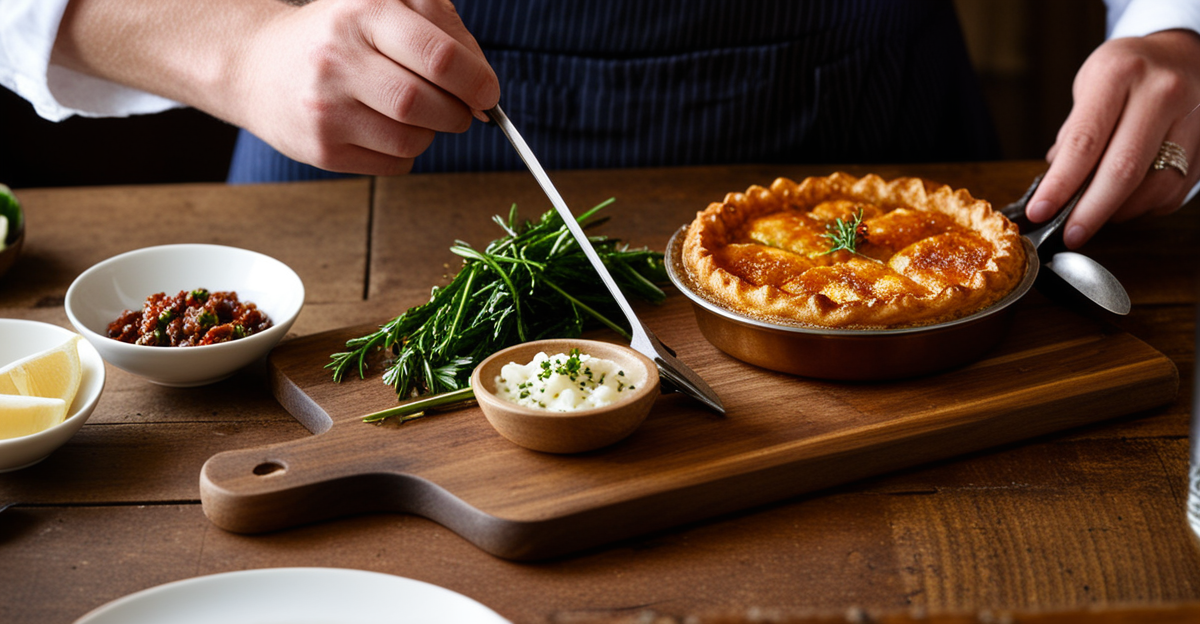Essential Staples in Classic British Cooking
The foundation of classic British cuisine rests on a core set of British staple ingredients that have shaped its distinct flavour and identity over centuries. These ingredients are not just components; they represent a heritage of food culture that binds diverse regional recipes into a cohesive culinary tradition.
At the heart of traditional recipes are simple yet robust staples like potatoes, root vegetables, various cuts of meat, and dairy products. Historically, these ingredients were readily available and sustainable, which cemented their role in the British diet. For example, potatoes became ubiquitous as an affordable, versatile energy source and found their way into numerous dishes, from mash to roast potatoes. Similarly, carrots, parsnips, and turnips helped diversify textures and flavours in soups and hearty stews.
Also to read : What are the essential components of a traditional ploughman’s lunch?
Meat and fish also hold a central place, with beef, lamb, and pork featuring prominently in staples like roast dinners and shepherd’s pie. White fish such as cod and haddock have long symbolized British coastal cuisine, especially in iconic meals like fish and chips. These traditional British proteins deliver both richness and texture that are unmistakably British in character.
Dairy ingredients such as butter, milk, and cheese have been integral in enriching and binding dishes, lending creaminess and depth. Eggs contribute structure, particularly in baked goods like Yorkshire pudding, while cheese adds savoury complexity in pies and bakes.
Topic to read : What are the essential components of a traditional ploughman’s lunch?
Finally, grains like wheat, oats, and barley are essential to British baking traditions. Wheat flour underpins bread, pies, and puddings, while oats and barley have roles in both soups and desserts, reflecting their agricultural significance.
Together, these staples—root vegetables, animal proteins, dairy, and grains—compose a pantry that supports the full spectrum of classic British cooking. Their historical importance and widespread use across regions underscore how these ingredients unify a cuisine celebrated for hearty, comforting dishes.
Animal Proteins Central to British Dishes
Animal proteins stand as the backbone of many traditional British proteins that define the flavour and texture of classic British cuisine. The most common British meats include beef, lamb, and pork, each bringing unique qualities to cornerstone dishes. For instance, beef often features in the iconic roast dinners, where its rich taste and tender texture pair beautifully with roasted vegetables and gravy. Lamb plays a starring role in shepherd’s pie, its distinctive flavour enhanced by slow cooking that melds meat and vegetable layers harmoniously. Pork also appears in various forms, from sausages in a traditional English breakfast to roasts that showcase its natural succulence.
White fish, such as cod and haddock, are equally essential to British culinary heritage, especially in meals like fish and chips. These British fish are prized for their flaky texture and mild flavour, which hold up well to deep frying. This cooking method produces a crisp, golden batter that contrasts delightfully with the tender fish inside, creating a dish that is both simple and iconic.
Animal proteins influence not just taste but also the mouthfeel and heartiness of dishes across Britain. Their presence often determines the structure of meals, providing a nourishing centre around which sides and sauces revolve. The enduring popularity of these staples highlights their crucial role in maintaining the distinctiveness and appeal of British culinary traditions.
Root Vegetables and Their Versatility
British root vegetables play a vital role in classic British cuisine, offering both flavour and texture across a wide range of vegetable dishes. Among these, potatoes stand out as a cornerstone ingredient. They are incredibly versatile, forming the base of iconic preparations such as chips, mash, and roast potatoes. These methods highlight potatoes’ ability to adapt to different cooking styles while maintaining their comforting appeal.
Alongside potatoes, carrots, parsnips, and turnips contribute depth and variety. Carrots add subtle sweetness and vibrant colour to soups and stews, while parsnips bring a nutty flavour that enriches both roasted vegetable medleys and hearty casseroles. Turnips, though less prominent, bolster many traditional recipes with their earthy taste.
The adaptability of British root vegetables is reflected in how they support and complement traditional recipes throughout the United Kingdom. For example, root vegetables often serve as essential components in rustic stews, balancing robust meat flavours and thickening broths naturally. Their presence helps unify regional dishes, maintaining the hearty, wholesome character emblematic of classic British cuisine.
Dairy Ingredients as Cooking Foundations
Dairy products enrich and hold many British dishes together.
British dairy products such as butter, milk, and cream are indispensable in classic British cuisine. Their role extends beyond simple flavouring; they provide essential moisture, richness, and texture that elevate traditional recipes. Butter, for instance, adds a creamy smoothness and depth to sauces, gravies, and vegetable dishes. It also plays a crucial part in the flaky textures of pastry crusts and the golden browning of baked goods.
Milk and cream contribute to binding ingredients, softening batters, and creating luscious custards, soups, and puddings. Creamy sauces often rely on these dairy components to balance robust flavours from meats or vegetables, creating the signature comfort associated with British cooking.
Eggs, another key British dairy product, are vital for structure and rise, especially in dishes like Yorkshire pudding. Yorkshire pudding’s light yet crisp texture comes from a simple batter of eggs, flour, and milk, demonstrating how these staples work in harmony. Beyond Yorkshire pudding, eggs are central in pastries and cakes, where they provide stability and a tender crumb.
Cheese stands out as a flavour enhancer, enriching pies, bakes, and gratins. Its savoury complexity and varying textures—from crumbly Cheddar to creamy Stilton—offer versatility across traditional recipes. Cheese often complements meats and vegetables alike, making it a staple in many British household kitchens.
Together, these British dairy products form the foundation for many beloved dishes, supporting both the taste and texture that define classic British cuisine.
Grains and Baking Essentials
In classic British cuisine, grains play a crucial role, especially wheat flour, which serves as the backbone of many British baking traditions. Wheat flour is fundamental in making bread, an everyday staple across the UK, as well as in pies and puddings that define the hearty character of traditional recipes. Its gluten content provides the necessary structure and elasticity, yielding breads with varied textures—from dense farmhouse loaves to light, airy crumpets enjoyed at teatime.
Oats and barley also hold historical and regional importance. Oats feature prominently in porridge and are often incorporated into desserts and baked goods, particularly in Scotland and northern England. Barley, once a central grain for brewing, also finds use in soups and broths, adding a subtle nuttiness and a slight chew that complements other staple ingredients.
The use of baking powders and raising agents is essential in achieving characteristic lightness and rise in scones and teatime cakes. These ingredients transform simple batters, turning them into fluffy, tender baked products that balance the richer components like butter and cream. Together, these grains and baking essentials underpin a wide spectrum of British culinary creations, ensuring texture and taste meet the expectations set by longstanding traditional recipes.
Signature Herbs, Seasonings, and Condiments
In classic British cuisine, British herbs play a subtle yet essential role in enhancing and defining traditional flavours. Common herbs such as parsley, thyme, and bay leaf are staples in many traditional recipes, valued for their ability to infuse dishes with depth and freshness without overpowering the main ingredients. Parsley is often sprinkled over roasts and stews to add a bright note, while thyme lends an earthy aroma crucial in slow-cooked meats and vegetables. Bay leaf, usually used in stocks and braises, provides a mild bitterness that balances richer flavours.
Condiments are equally foundational to British cooking, serving as companions that bring contrast and complexity to meals. Mustard is a classic pairing for British meats like beef and pork, offering sharpness that cuts through fat and richness. Malt vinegar holds an iconic place alongside fish and chips, its tangy acidity enhancing the crispy texture and mild fish flavour. Mint sauce traditionally accompanies lamb dishes, providing refreshing brightness that complements the meat’s intensity.
Seasonings such as salt and pepper are indispensable in all traditional recipes, underpinning the British palate’s preference for well-balanced but straightforward taste profiles. Salt enhances natural flavours, while pepper adds gentle heat and complexity. Used judiciously, these basic seasonings elevate every dish from simple boiled vegetables to hearty roasts.
Together, this trio of herbs, condiments, and seasonings forms a seasoning framework that supports and accentuates the key ingredients in classic British cuisine. Their thoughtful use ensures that traditional flavours remain distinct and well-rounded, preserving the culinary heritage cherished across the United Kingdom.








